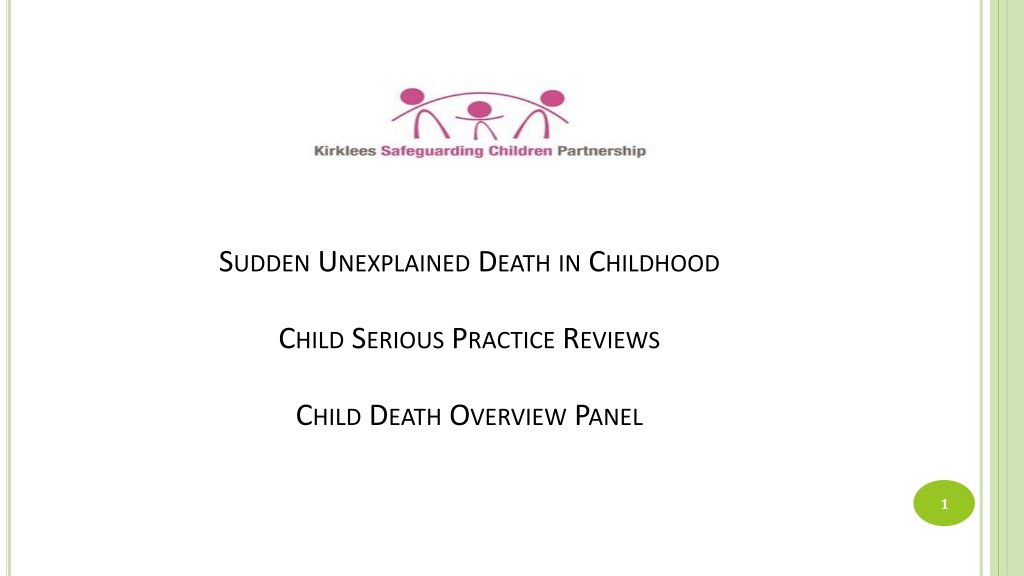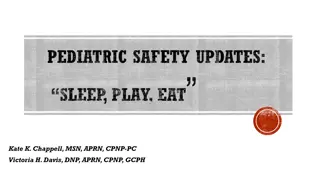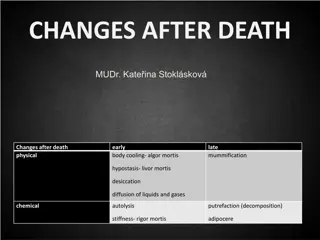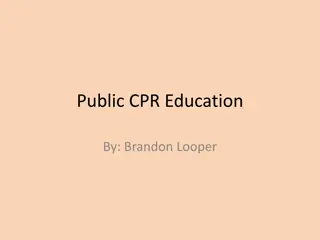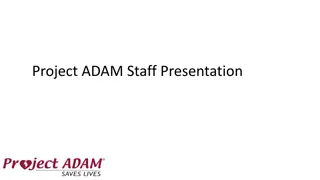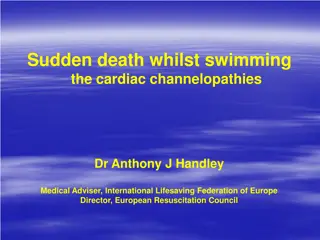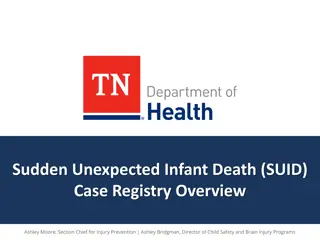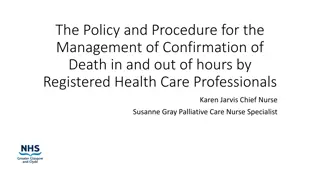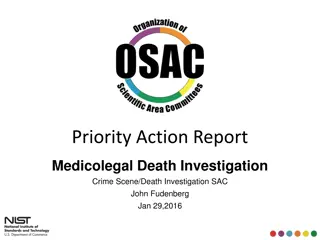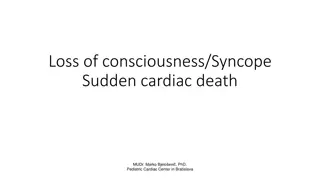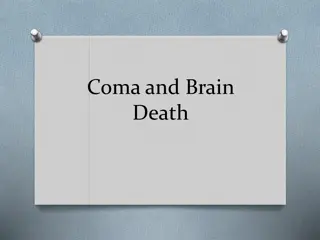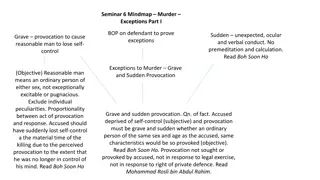Understanding Sudden Unexpected Death in Childhood (SUDIC)
Sudden Unexpected Death in Childhood (SUDIC) refers to the sudden and unexplained death of a child, often referred to as Sudden Unexpected Death in Infancy (SUDI) or Sudden Infant Death Syndrome (SIDS). While the exact causes of SIDS are unknown, there are ways to reduce the risk, such as safe sleep practices and avoiding exposure to smoke. In cases where a child's death is unexpected or suspicious, a Joint Agency Response may be required for investigation and support.
Download Presentation

Please find below an Image/Link to download the presentation.
The content on the website is provided AS IS for your information and personal use only. It may not be sold, licensed, or shared on other websites without obtaining consent from the author. Download presentation by click this link. If you encounter any issues during the download, it is possible that the publisher has removed the file from their server.
E N D
Presentation Transcript
SUDDEN UNEXPLAINED DEATH IN CHILDHOOD CHILD SERIOUS PRACTICE REVIEWS CHILD DEATH OVERVIEW PANEL 1
WHATIS SUDI/SUDC 'The sudden and unexpected death of a baby is usually referred to by professionals as sudden unexpected death in infancy (SUDI) or sudden unexpected death in childhood (SUDC), if the baby was over 12 months old. The death of a baby which is unexpected is also sometimes referred to as sudden infant death . 2
WHATCAUSES SIDS We do not know what causes SIDS. For many babies it is likely that a combination of factors affect them at a vulnerable stage of their development, which leads them to die suddenly and unexpectedly. Is SIDS very common? While SIDS is comparatively rare 200 babies died of SIDS in the UK in 2017 it can still happen and there are steps you can take to help reduce the chance of it occurring. 3
CAN SIDS BEPREVENTED? WHATARETHEBIGGESTRISKFACTORS? While SIDS cannot be completely prevented, you can reduce the risks of it occurring considerably by following safer sleep advice. For example: Sleep your baby on their back for all sleeps day and night as this can reduce the risk of SIDS by six times compared to sleeping them on their front. Share a room with your baby for the first six months this can halve the risk of SIDS. 4
Keep your baby smoke-free during pregnancy and after birth this is one of the most protective things you can do for your baby. Around 60% of sudden infant deaths could be avoided if no baby was exposed to smoke during pregnancy or around the home. Never sleep on a sofa or armchair with your baby as this can increase the risk of SIDS by 50 times. Do not co-sleep with your baby if you or your partner has been drinking, is a smoker, has been taking drugs or is extremely tired; these factors can put babies at an extremely high risk of SIDS when co-sleeping. One study found that the risk of SIDS when co-sleeping is six times higher in smokers than in non-smokers. The above is especially important for babies who were born premature or of low birth weight, as these babies are at a higher risk of SIDS 5
SUDIC JOINTAGENCYRESPONSE A Joint Agency response is required if a child`s death Is or could be due to external causes. Is sudden and there is no immediately apparent cause (including sudden unexpected death in infancy/childhood). Occurs in custody, or where the child was detained under the Mental Health Act. Occurs where the initial circumstances raise any suspicions that the death may not have been natural. Occurs in the case of a stillbirth where no healthcare professional was in attendance. Nationally some of the child deaths that trigger a JAR are: o Significant abdominal symptoms rather than respiratory symptoms o Sudden witnessed collapse of older children when they are doing something eg riding a bike (Information provided by NCMD) 6
INITIAL DISCUSSION Following the home visit, the lead health professional and police investigator should review all information gathered to date. This may be done through an initial case discussion or within a multi-agency meeting, particularly where there are complex circumstances surrounding the infant s death. Following this review, the lead health professional should prepare a report of the initial findings, to include details of the history, initial examination of the infant and findings from the home visit, as well as an account of any medical investigations and procedures carried out. 7
FINAL DISCUSSION As soon as possible, once the results of all relevant investigations have been obtained, a multi-disciplinary local case discussion meeting should be held. review all information pertaining to the circumstances of the death, the background history and findings of investigations in order to determine, as far as is possible, the likely cause of death and any contributory factors identify any lessons arising from the case that may help prevent future deaths consider any ongoing support needs of the family, including any information offer a supportive environment for the professionals involved to reflect on the case and their involvement needs and care requirements of current and subsequent children 8
CONTINUED The local case discussion meeting should ideally take place before the coroner s inquest and before the CDOP reviews the death. A report from the meeting should go to the coroner to assist in his or her investigation. A report should also go to the CDOP to assist in their review of the case and in identifying learning arising from the case. A suitable proforma such as the CDOP Form C classification may be used to record the conclusions of the meeting. 9
RESPONSIBILITYANDATTENDINGPERSONS. Responsibility for convening and chairing the meeting should be agreed in advance by the lead health professional and the lead police investigator. All relevant professionals who were involved with the infant or family, either at the time of death or previously, should be invited to the meeting. This should include: the lead health professional (designated paediatrician and/or specialist nurse), primary care staff (GP and health visitor or midwife),emergency department staff ,all those involved in the emergency response, ambulance crew, the police investigator, the coroner s officer, the pathologist, children s social care, where they have been involved. 10
OTHERCONSIDERATIONS During the course of this case discussion meeting, it is important that there is an explicit discussion of the possibility of neglect or abuse as a contributory factor to the infant s death. If no evidence is identified to suggest neglect or abuse as contributory factors, this should be documented as part of the report of this meeting. The quality of both medical and social care that was given to the infant and family should also be discussed at this meeting, identifying any shortcomings and appropriate measures to improve future care 11
Abuse or neglect of a child is known or suspected Reasons for a CSPR AND the child has died or been seriously harmed 12
SERIOUSINCIDENT RAPIDREVIEWPROCESS Requirement under the new arrangements that a Rapid Review is completed and sent back to the National Panel for every incident within 15 days The Serious Incident Rapid Review includes: A brief description of the serious incident Whether the criteria for a CSPR has been met Brief outline of case history Action taken to safeguard the child or children Any themes of National concern that have been identified Immediate learning and how this will be disseminated Potential for additional learning Decision and rationale on the type of review that will be undertaken (if any) The agencies and staff who have made this decision 14
CHILD SAFEGUARDING PRACTICE REVIEWS Taken from Working Together 2018 The purpose of reviews of serious child safeguarding cases, at both local and national level, is to identify improvements to be made to safeguard and promote the welfare of children. Learning is relevant locally, but it has a wider importance for all practitioners working with children and families and for the government and policymakers. Understanding whether there are systemic issues, and whether and how policy and practice need to change, is critical to the system being dynamic and self-improving. Reviews should seek to prevent or reduce the risk of recurrence of similar incidents. They are not conducted to hold individuals, organisations or agencies to account, as there are other processes for that purpose, including through employment law and disciplinary procedures, professional regulation and, in exceptional cases, criminal proceedings. These processes may be carried out alongside reviews or at a later stage. Employers should consider whether any disciplinary action should be taken against practitioners whose conduct and/or practice falls below acceptable standards and should refer to their regulatory body as appropriate. 15
DIFFERENTTYPESOFREVIEW Safeguarding Practice Review (local) Single Agency Audit Single Agency Review Safeguarding Practice Review (national) Child Death Overview 16
ROLEOF CHILD SAFEGUARDINGNATIONAL PANEL Understand how the system learns the lessons from serious child safeguarding incidents lies at a national level Identify and oversee the review of serious child safeguarding cases which, in its view, raise issues that are complex or of national importance. Maintain oversight of the system of national and local reviews and how effectively it is operating. 17
ROLEOF LOCAL SAFEGUARDING CHILDREN PARTNERSHIPS(SPR S) Identify and review serious child safeguarding cases which, in their view, raise issues of importance in relation to their area. Commission and oversee the review of those cases, where they consider it appropriate for a review to be undertaken. Identify improvements to practice and protecting children from harm Maintain an open dialogue with the National Panel to share concerns, highlight commonly-recurring areas that may need further investigation (whether leading to a local or national review), and share learning, including from success, that could lead to improvements elsewhere. 18
CDOP NOTIFYINGTHE KSCP OFACHILDDEATH Agencies notify the KSCP of a child death by following the link below. The link to the site allows users to fill and submit two forms to notify the team of an expected or unexpected death. https://www.kirkleessafeguardingchildren.co.uk/safeguarding- 2/safeguarding-processes-and-systems/child-death-review- process/ ALL CHILD DEATHS SHOULD BE NOTIFIED TO THE KSCP WHETHER THEY AS A RESULT OF ABUSE OR NEGLECT OR NOT
THE CHILD DEATH REVIEW PROCESS The Child Death Overview Panel (CDOP) is set up to systematically gather comprehensive data on children s deaths, to identify notable and potentially remediable factors, and to learn lessons and make recommendations to reduce the risk of future child deaths. The statutory basis of the CDOPs is documented in Working Together. The CDOP manager should be notified according to local protocol whenever an infant dies. For sudden unexpected deaths, this should be done following presentation by the lead health professional. At the conclusion of the joint agency response, a copy of the report of the final case discussion should be sent to the CDOP manager for inclusion in the documentation compiled for the CDOP meeting. The CDOP manager should also be provided with other relevant documentation, including, where appropriate, completed forms B or C and the initial report to the coroner and pathologist. 20
CHILD DEATH PANEL REVIEWFORMSANDPROCESS What is a Reporting form? If you have had close involvement with the child it may be that you will be asked to provide further information, this will be sent to you by a secure link via eCDOP that will enable you to enter details on your involvement with the child. When the KSCP CDOP Coordinator receives a death notification they will create a new case and send out Reporting form requests for agencies to complete. The user will receive an email from QES. The email includes a link to the database/Reporting form. 21
WHY CDOP The CDOP is a multi-agency panel that meets on a regular basis to review all children s deaths. Cases of sudden unexpected deaths should normally be scheduled for discussion at the CDOP after the conclusion of the full joint agency response, including the final case discussion and the coroner s inquiry. The CDOP should review all relevant information provided on the case from the different agencies involved. It should consider any relevant contributory factors in each domain (factors intrinsic to the infant, parenting capacity, family and environment, service delivery) and form an opinion as to the relevance of such factors. The CDOP should form an opinion on the cause and category of the infant s death, and on whether they consider the death to have been preventable according to the definition in Working Together. The CDOP should consider any learning arising from their review any appropriate recommendations. 22
CDOP: WHAT YOU CAN DO Support healthy behaviours Be aware of vulnerable groups and individuals Help women to access maternity services Raise awareness of issues such as accident prevention etc. Provide awareness to immediate family members, including fathers and other caregivers 23
